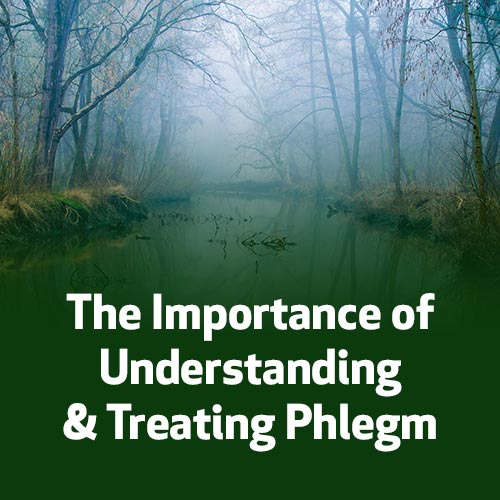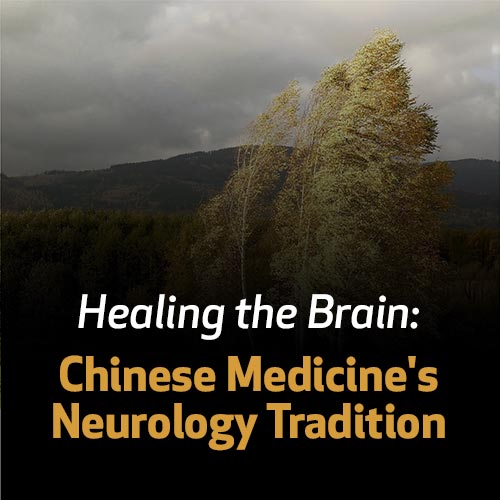Phlegm
Part of the brilliance and deep reaching clinical efficacy of Chinese medicine is its ability to make seemingly difficult and confusing conditions clear and accessible. One example is the understanding of the different origins of tan/phlegm.
In our modern discussion, we often emphasize phlegm as coming from pathology of the Spleen as it is associated with the Earth phase and the climatic influence of dampness. And while the Spleen and Earth can be a cause of dampness all five phases can also be involved and there are seven different types of phlegm. Interestingly, in the long history of Chinese medicine there is no major tradition that emphasizes phlegm as the root cause of disease. In other words, it’s understood that phlegm is a branch issue that is responding to other deeper pathology.
The Five Phases and Seven Types of Phlegm
- Damp Phlegm/Earth: Associated with the Spleen, this is what we often currently associate with dampness. Damp phlegm can both come from--and contribute to-- weakness in the digestive system (Stomach/Spleen) and affect day-to-day energy through its weaking of the creation of post-natal Qi. Treatment strategies include transforming and expelling phlegm.
- Dry Phlegm/Metal: Associated with the Lung, this is phlegm that occurs as the body’s response to a lack of healthy fluids. As result, the Lung and the body in general can create or hold on to thicker fluids because thinner, less viscus ones are not available. As the Lung is also associated with the creation of post-natal Qi, dry phlegm can also create weakness and tiredness. Unlike with damp phlegm above which focuses on drying, the treatment strategy here is to moisten.
- Cold Phlegm/Water: This is where the fluids can become thicker and heavier from the congealing presence of cold. And with its association with the Kidney, cold phlegm can both come from--and contribute to-- issue of Yuan/Source Qi. The treatment strategies include clearing cold and tonfiying Kidney Yang.
- Fluid Phlegm/Water: Also associated with the Kidney. Fluid phlegm occurs when the phlegm in the middle burner descends into the lower burner and begins to affect the Kidney and Yuan/Source Qi. A way to differentiate fluid phlegm from cold is that in this case their may be the accumulation of fluids and edema in the lower part of the body. As with cold phlegm above, the treatment strategies include clearing cold and tonfiying Kidney Yang.
- Wind Phlegm/Wood: An interesting and important type of phlegm to understand in several seemingly hard to treat diagnoses including a wide range of neurological conditions and late-stage Lyme. Wind is an excess of Yang in the Liver and tends to go upward and phlegm is an excess of Yin which tends to descend. Understanding that the directionality of wind and phlegm can be responding to each other--including as a response to create balance—can be relevant clinically and important in understanding that one imbalance can create others. The treatment strategy includes subduing wind.
- Hot Phlegm/Fire: Hot phlegm can occur in the Heart and other organs (particularly the Stomach) and can appear as the body attempts to use the cooling and heavy nature of the Yin of phlegm to control the ascending and warm nature of Yang and fire. As heat can also cause dryness, hot phlegm and dry phlegm can occur simultaneously and sometimes in the same organ. The treatment strategies are to clear heat and tonify Yin.
- Insubstantial Phlegm/Fire: Associated with the Heart, insubstantial phlegm is used to describe a condition where--based on signs and symptoms or disease progression—phlegm should be present but is not found diagnostically. As the treatment principles to address the condition are associated with the Heart--including the idea of vaporizing phlegm--much of focus on treating insubstantial phlegm relates to the upper burner.
Other Courses By This Teacher




COVID and Climate Crisis: Personal and Ecological Healing
with Brendan Kelly
Overview
Embedded in the long history of Chinese medicine is the understanding that we are intimately connected to the world around us. Using contemporary western climate science and a traditional Chinese medicine understanding of epidemics, we'll discuss the direct, immediate connection between COVID and the destabilization of the climate. Brendan also uses the ideas and research from his book “The Yin and Yang of Climate Crisis” to discuss the bigger and deeper issues connected to our warming planet including imbalances in our economic and medical systems as well as what we value individually.
We’ll also use the lens of the Chinese medicine's School of Heat/Wen Bing tradition--which was developed starting in the 1300s in response to other epidemics— to provide a larger, cultural view of the underlying conditions that contribute to creating wide-spread sickness and disease. Brendan will also discuss his clinical experience using western and eastern herbs to treat Chinese medicine's understanding of COVID and other viral infections.
Learning Objectives
- Understand the connection between the deeper root issues that create the indivdual and societal conditions for COVID and climate change.
- Understand the use of eastern and western herbs to treat a Chinese medicine understanding of COVID.
- Understand a Chinese medicine view of COVID and other viral infections based on the principles from the School of Cold/Shang Hun Lun.
- Understand the basics of western climate science.
- Understand a Chinese medicine view of the development of epidemics based on principles from the School of Heat/ Wen Bing tradition.
Your Teacher

Brendan Kelly
Brendan Kelly LAc is an acupuncturist, herbalist, author and professor who has been practicing Chinese medicine full-time since 2004. His first book “The Yin and Yang of Climate Crisis” uses the lens of Chinese medicine to look at the bigger and deeper issues of global warming.
Categories
Tags
Overview
Using the lens of the School of Cold/Shang Han Lun, we’ll discuss a Chinese medicine understanding of viral infections including COVID19. We’ll look at the progression of viruses and how they can transform into heat/inflammation and effect several organ systems including respiration/Lungs, circulation/Heart, digestion/Stomach and Spleen and cognition through affecting the brain.
Brendan will also discuss his clinical experience treating a Chinese medicine understanding of COVID19 and long-haul COVID with acupuncture, herbs and eastern nutrition.
"Disclaimer: there are no proven treatments for Covid-19”
Learning Objectives
- Have an understanding of the importance of the Shang Han Lun/School of Cold in treating viral infections.
- Have a Chinese medicine based understanding of the nature of most viral infections including COVID-19.
- Have an understanding of the rates of COVID and long COVID in the US and the larger societal issues associated with pandemics. Also have an understanding of the importance of translating the western diagnoses of both conditions into Chinese medicine.
- Have an understanding of the importance of the application of the Wen Bing Xue/School of Heat in treating the inflammation common with viral infections including COVID-19.
- Have an understanding of the importance of integration of different Chinese medicine traditions--specially the Shang Han Lun and Wen Bing Xue-- in treating multi-organ, multi-system conditions including COVID-19.
Your Teacher

Brendan Kelly
Brendan Kelly LAc is an acupuncturist, herbalist, author and professor who has been practicing Chinese medicine full-time since 2004. His first book “The Yin and Yang of Climate Crisis” uses the lens of Chinese medicine to look at the bigger and deeper issues of global warming.

